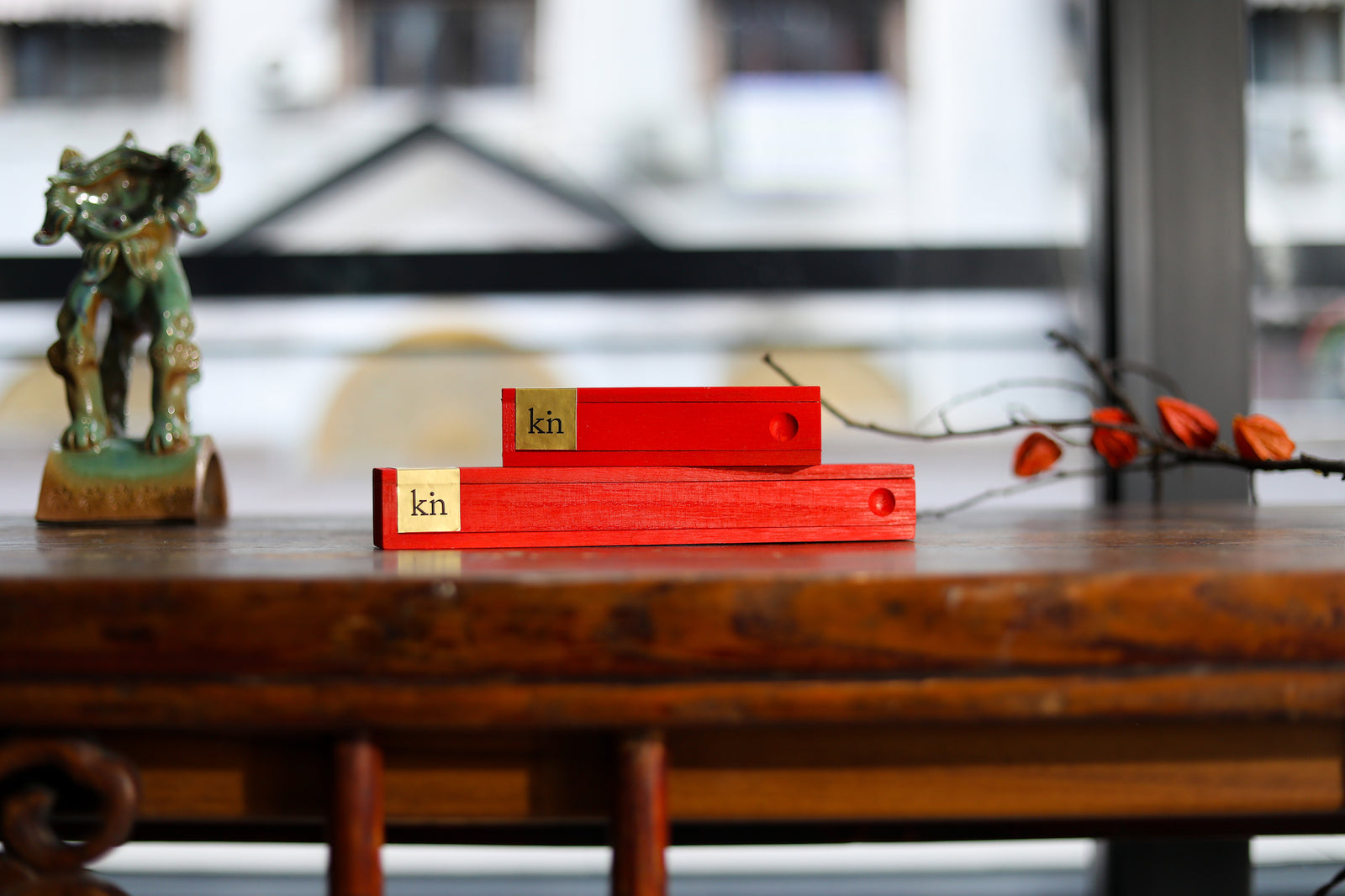Have you ever experienced the soothing aroma of incense filling a room, transporting you to a serene and tranquil state of mind? The ritual of burning incense has been cherished across the world since ancient times - in fact for as long as human civilizations itself - and offers a myriad of benefits that go beyond its pleasant fragrance, many of these now proven scientifically. Let’s embark on a journey to explore the untold health and spiritual benefits of burning incense.
The Relationship Between Smell and Mind
Scent is one of our most primal senses, and has the power to evoke powerful emotions, memories and actions.
There is now extensive evidence that odors can modulate mood and emotion, whether overtly or subconsciously (Kontaris et al., 2020). For example, 5 minutes of exposure to a pleasant scent can induce positive mood and calm, while 5 minutes of exposure to an unpleasant scent has been reported to induce a negative mood and mild anxiety. I'm sure we've all personally experienced this - the smell of a particular dish my grandmother used to prepare brings back fond childhood memories; and on the other hand I still clearly remember the pungent smell of a woman's perfume - she sat next to me at a concert when I was about twelve years old, I almost threw up mid-way.
What comes to mind and how we react when a scent flows into our nostrils is instantaneous, and can trigger thoughts, feelings and bodily reactions far from our conscious mind.
A Brief History of Incense Use

An ancient bronze incense burner dating from Eastern Zhou (770–256 BCE) – Han (206 BCE–220 CE) dynasty, Met Museum Collection
Incense boasts a rich history spanning thousands of years, with roots in many cultures - ancient China, ancient Egypt, Babylon and beyond. These civilizations utilized incense for many cultural, spiritual, and therapeutic purposes. Made from a variety of plant-based resins, barks, seeds, roots, leaves and flowers, incense has been used to aromatize rooms and clothing, as an essential part of religious rituals and spiritual practice, and as an enjoyable pursuit for scholars and nobility.
Throughout ancient Chinese dynasties, incense played a vital role in society and culture. Incense use flourished during the Song dynasty (approx. 900-1200 CE), as nobility embraced it as a beloved pastime, with lavish rooms dedicated to incense ceremonies. Incense also made its way from China to Japan through Buddhism, and it remains an essential part of Buddhist religious practices in both countries until today. Incense was an inextricable part of Chinese Traditional Medicine, which considered preventative healthcare via inhaling incense a far superior form of therapy than consuming medicine when ill.
Aromatherapy: Incense Benefits for the Mind

Aromatherapy is the practice of using scents to enhance physical, mental and overall well being. Today it is widely associated with inhaling plant-based essential oils via a diffuser, but incense burning is the oldest form of aromatherapy.
Aromatherapy can offer numerous mental health benefits. Some of these health benefits include reduction in stress and anxiety, aid sleep, enhancement of focus, mental performance, memory and creativity levels.
Many randomized trials have been conducted in recent years to test the effectiveness of inhaling plant-based scents, and the body of positive results is growing. We will be summarizing just a small portion of the studies below.
Anxiety Relief and Anti-Depressent
Today it is widely accepted that aromatherapy reduces stress and anxiety, relieve depression and promote relaxation.
In both animals and humans trials, certain scents, like lavender, citrus and those from green leaves have been found to have anxiolytic (anxiety reduction) effects, so much so they are comparable to those induced by medication. For example, in animals, lavender aroma exposure may modify GABA receptor signaling (Ballanger et al., 2019) or serotonergic signaling (Chioca et al., 2013), both of which are targeted by pharmacological anxiolytics. Green leaf odors that can produce anti-depressive effects in mice acts in part by elevating serotonin, similar to some pharmacological anti-depressants such as selective serotonin reuptake inhibitors SSRIs (Nakatomi et al., 2008).
A randomized trial where elderly people inhaled chamomile and lavender essential oil daily for a month also showed statistically significant improvements in depression, anxiety, and stress levels immediately and one month after the intervention compared to the control group (Ebrahimi et al., 2020).
Sandalwood is the world's most used incense ingredient. Its active ingredients α- and β-santalols have been scientifically proven to have neuroleptic properties – ie, they reduce nervous tension and stabilize mood. In trials with mice, its effects bear resemblance to the drug chlorpromazine, used to manage and treat schizophrenia, bipolar disorder, and acute psychosis (Okugawa et al., 1995).
Improved Sleep

For many people, getting a good night's sleep can be a challenge. But scientific research has shown that olfaction (our sense of smell) has an important modulatory role over sleep. Odors can influence how easily we fall asleep, as well as the quality and duration of sleep. For example, studies have demonstrated that lavender oil inhaled prior to bed time was associated with more time spent in non-REM sleep in humans compared to no odor (Goel et al., 2005).
In another study using polysomnography, several distinct odors (e.g., lavender or vanilla) which were inhaled during sleep increased indicators which indicated improved sleep quality (Perl et al., 2016).
Boosting Concentration, Focus and Creativity
In ancient China, incense was an essential accompaniment to all tasks that require focus and creativity - from painting, calligraphy, poetry, music, to moments of contemplation, reflection and important political and military discussions. The ancient Chinese believed that incense helps increase focus and stimulate creativity, helping the mind reach their full potential in these moments. Today, scientific studies support this.
For example, studies on rat mothers that consume frankincense have shown better learning and memory performance in their offsprings, and frankincense has also been effective in reducing the effect of memory deficit in rats with thyroid hormone deficits (the thyroid hormone plays a significant role in the functioning of the central nervous system) (Hamidpour et al., 2013).
Another study (Moss et al., 2003) on 140 healthy adults showed that inhaling Rosemary enhanced quality of memory and improved mood, and a smaller study (Sayorwan et al., 2013) showed that Rosemary had the effect of a psychostimulant, where study participants who inhaled Rosemary essential oil for 20 minutes exhibited increased Heart Rate, Blood pressure and Respiration Rate. Similar effects have been shown for a range of other plant matters and other incense fragrances like Ylang ylang, Roman Chamomile, Patchouli and Peppermint (Lizarraga-Valderrama et al., 2020).
How Incense Supports Meditation and Yoga Practice, and Enhances Spiritual Rituals
It is therefore no wonder that incense has been used to support meditation, yoga, and spiritual practices for millennia. Its calming and stress-reduction properties are a natural complement for these activities, and the two reinforce each other in many aspects.
The Healing Power of Incense: Natural Remedies and Therapeutic Effects

Incense ingredients also have a range of therapeutic effects, such as anti-inflammation, infection-prevention, pain relief and immunity boost.
Anti-Inflammatory Properties
Many incense ingredients are commonly used in Traditional Chinese Medicine for their anti-inflammatory properties. A few examples include frankincense, mugwort (or wormwood), ginger, tumeric, cinnamon and angelica.
The main active ingredients in frankincense are a family of boswellic acids. Among these, 3-O-acetyl-11-keto-β-boswellic acid (AKBA) is the most important inhibitor of an enzyme called 5-lipoxygenase, which is responsible for inflammation. AKBA has shown to be effective against a large number of inflammatory diseases such as arthritis, bronchial asthma, chronic colitis, ulcerative colitis (UC), Crohn's disease (CD), and cancer (Hamidpour et al., 2013).
Studies of ginger have also shown anti-flammatory properties against skin conditions such as contact dermatitis. It does this by regulating a range of proteins involved in the body's inflammatory response, including increasing the expression of IL-4, a cytokines that regulates the responses of lymphocytes, myeloid cells, and non-hematopoietic cells in allergic inflammation (Zuo et al., 2020).
Infection Prevention and Germ Elimination
Many incense ingredients have powerful antibacterial properties that can effectively eliminate germs in the environment, making them excellent tools for protecting against infections. In traditional Chinese culture, the ash from burnt incense was commonly used as a convenient daily ointment, often dabbed and directly applied to insect bites, minor wounds and skin irritations because of its dual antiseptic and anti-inflammatory properties.
This traditional practice makes perfect sense given the results of more recent studies. Shamsi et al. (2014) shows that sandalwood significantly inhibits a range of microorganism growth (65%-85% inhibition) Similarly, frankincense's anti-bacterial and anti-fungal properties have been scientifically proven (Di Stefano et al., 2020). Both of these have not only demonstrated their effectiveness against common bacterias, but also strains of antibiotic-resistant bacteria. And as the number of antibiotic-resistant bacteria increases, scientists and doctors are turning more and more to traditional medicines in their quest to search find new strategies of managing these bacteria.
Pain and Discomfort Relief
Incense can be beneficial for pain and relieve discomfort. The effect of plant materials to alleviate pain is more obvious when applied directly onto the skin, but several studies have demonstrated the effectiveness of inhalation when used in events where this is more practical. For example, inhalation of lavender and eucalyptus resulted in lower pain during dialysis, C-section, natural labor and post-operative recovery (Lakhan et al., 2016).
Immunity Boost
Many incense ingredients also have immune-supporting properties, and have long been used for this purpose. These have not been studied as extensively as their anti-inflammatory properties, but there is still a body of evidence that support this. For example, in immunosuppressed mice, clove restored cellular and humoral immune responses. Ginger EO was also able to improve the humoral immune response in immunosuppressed mice. In a small human study, a citrus-blend fragrance showed restorative effects of the immune function, affecting CD4/CD8 T cell values and NK cell activity (Peterfalvi et al., 2019).
Practical Uses of Incense: From Air Purification to Insect Repellent

In addition to the mental and physical benefits we mentioned above, incense also has numerous practical daily uses, including air purification and acting as a mosquito and insect repellent.
Natural Air Freshener and Purifier
Incense acts as a natural air freshener and purifier in two main ways. The more obvious one is that it releases a pleasant, aromatic fragrance into the air, which can mask unpleasant odors.
But the purification effects go far beyond this. Studies have also shown that the antibacterial properties of plant oils (mentioned above) also works in the air. In one study, the concentration of airborne bacteria and fungi was found to be 30-60% lower in the two hours after lemon and silver fir essential oils were dispersed into the air (Alicia Lanzerstorfer, 2019).
This is hardly surprising as many ancient and traditional cultures burn incense sticks for the purpose of purifying the air. In many cultures, incense is associated with the ritual of purification, clearing out of negative energy, and driving away evil spirits during major festivals and changes of seasons.
We should also point out here that incense smoke does release small quantities of particles into the air. While there is no evidence that these quantities are harmful for human health (see our discussion of this here), we'd still recommend keeping the area ventilated.
Mosquito and Insect Repellent
The ability of certain incense, to act as a mosquito and insect repellent is widely known. There are many ingredients in incense that make it incredibly effective against mosquitoes and insects, these include but are not limited to citronella, lemongrass, rosemary, peppermint, clove, cedarwood, sandalwood.
Studies have shown that citronella-based incense and candles can provide a 20 to 40 percent decrease in the chance of a mosquito bite (Lindsay et al., 1996).
Choosing the Right Incense: Natural vs. Synthetic Fragrances
While we have outlined many benefits of burning incense above, all of these benefits are predicated upon the condition that the incense is all natural, with no synthetic additives.
Synthetic fragrances in incense can potentially cause allergies or skin reactions, shortness of breath, sneezing, headaches, coughing, and eye or throat irritation. We discuss the topic at length in our article "Is Burning Incense Bad for You?" because what is widely sold on the market today are low quality products, where the typical composition consists of subpar wood powder along with substantial artificial enhancements. These types of incense cannot deliver any of the benefits we discussed here.
It is natural ingredients that deliver the therapeutic benefits of the incense. And once you are used to all natural incense (as I am), you will instinctively find synthetic fragrances irritating to the nose and repelled by your body. On the contrary, a natural aroma is soothing, comfortable, and finds its way naturally into the body. We strongly advocate that you buy incense made from all natural ingredients.
How is Using Incense different from Essential Oils?
Incense uses the entire part of the plant (or in a small number of instances, part of an animal), while essential oil is purely the oil extracted from the plant. Incense releases its aroma and benefits by heat, while essential oil is diluted with water and then vaporized for inhalation.
While both methods allow us to enjoy the benefits offered by the plants, each method also has its own pros and cons.
Essential oils are highly concentrated, and if not diluted correctly, or inadvertently spilled onto bare skin, can cause irritation, inflammation, and in more severe cases burns, sensitization and shortness of breath. Using undiluted oils on children can be especially dangerous. Essential oils are also highly volatile and have a limited shelf life, especially those from the citrus family, which need to be used within 1-2 years. On the other hand, essential oils have the benefit of being able to be used in oils, creams and other ointments, and can be directly applied onto the skin with ease.
Incense poses its own health risks as it's a flammable substance, so care needs to be taken while it's lit, especially around children and pets. It is also not practical to apply onto the skin. However, as incense is made from dried plant materials, it is quite stable, and can be kept for a long period of time if the environment is not too damp or hot (just like the dried herbs we often use). In fact, many incense only get better with age (much like red wine) if stored in a dry, cool climate.
In this journey through the world of incense, we’ve discovered its history, mental health benefits, healing properties, and practical uses. Choosing high-quality, natural incense can offer various benefits and create a more pleasant and inviting atmosphere. So, why not explore the captivating world of incense and experience its wonders for yourself?






Leave a comment (all fields required)